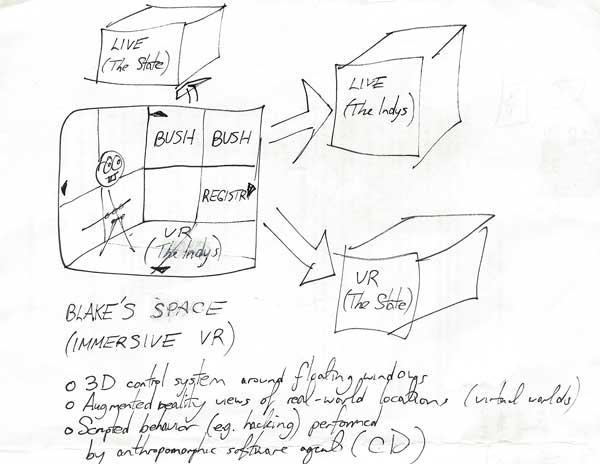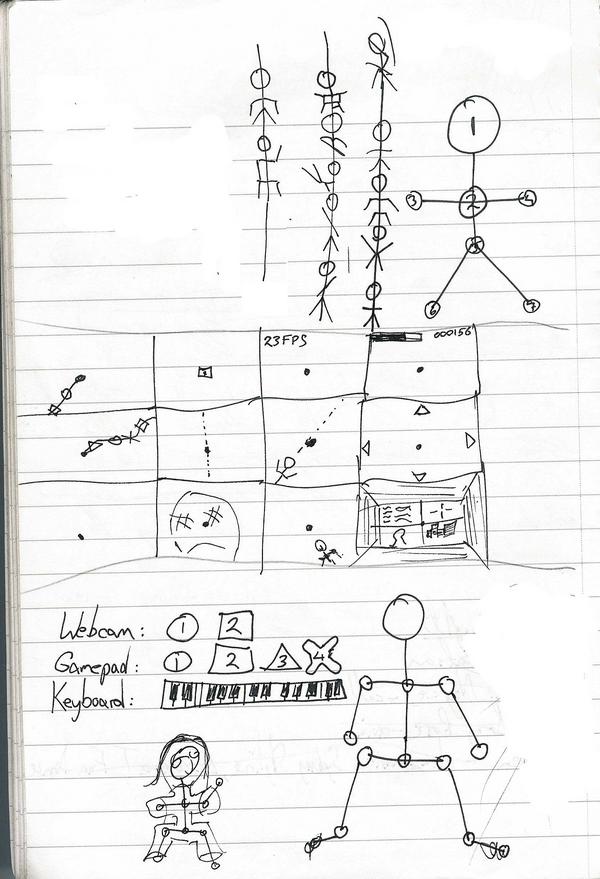August 17, 2004
GUI aesthetic in Sanctuary
SPACE
Our hero (Blake) is a hacker, able to move freely between different computer systems, represented by different GUIs. The aim is to enable a passive non-technical audience to understand Blake�s power over virtual worlds, and any constraints, in a realistic manner. This constitutes the film�s �hacker� aesthetic.

The story is set in the �near future� after the point where there has been a fundamental step in the evolution of the man-machine interface. A non-invasive technology called The RIG can be used to plug into the mental processes of any willing user and use this data to render an �augmented reality� point of view (POV). This POV can be of a wholly virtual world (e.g. the State Registry) or a view of the real world (e.g. the bush) as recorded by surveillance hardware. Surveillance is all-pervasive. Smart networks monitor the world.
In the story, the RIG is as common as the Eye-Toy is in 2004, a paradigm seeping into mainstream awareness as early-adopters use and abuse it.
The characters in the story do not distinguish between real-world footage (surveillance cameras), virtual world visualisation (photo-realistic data rendering) and recorded brain activity (character POVs). The key suspension of belief has to be that technology has advanced to the point that context is the only way to determine what is real. Any data source can be made to look the same. Hence the term the State uses to collectively refer to all its recorded data � �virtual memory�.
Sanctuary makes little reference to how the virtual worlds operate. The focus is on watching Blake rather than understand what she�s doing. The notion that everything has been recorded by the system is only revealed in the credits, a pay-off and incentive to re-run and play.
The degree to which the RIG can be used depends primarily on what OPS (Operator Privileges) are available. For example, the State�s surveillance system within the sanctuary is only supposed to be available to privileged State personnel. Blake�s power is that she can steal OPS.
TIME
The film leads the audience through the story in �real-time�, witnessing how Blake becomes Blade as events actually unfold.
The film�s payoff is that anything is record-able. All the events witnessed have been captured within the State�s �virtual memory�, setting up the premise for the wider story universe explored in ten weeks in the head bin.
"Anything is record-able" is a fundamental rule of this world. Any POV shown in the film, in the context of the narrative, can be replayed by accessing a system with the right level of OPS. It is no coincidence that the whole film functions as a loop.
Blade�s origin story is preserved for subsequent review by characters themselves as well as the audience. The film functions as a time-capsule and seeds the idea that there are other characters sifting through �virtual memory� along with the audience.
GUI
Big Brother meets Little Brother

The story-telling involves the use of three visually distinct GUIs. The use of these GUIs is a device for depicting visually, to the film audience, what kind of OPS are available. Each GUI places restrictions on what can or can�t be done by the user.
- The State interface � run by the Department of the Environment and Network Resources, the standard government interface across all public and secret government services. Think futuristic 3D, corporate styling.
- The Activists' interface � run by eco-activists who monitor the State. Think minimalist 2D, purely functional (e.g. old school Linux) styling.
- The �Customised Dude� interface � run by Blake, a personal interface to virtual worlds, hacked from illegal software swiped from her father�s home office. Think crude but highly flexible stick figure plastered onto top of (or embedded within) other systems.
The challenge will be to cleanly depict each of these GUIs in the narrative whilst creating opportunities for the audience to mimic Blake�s GUI-hopping behaviour in the real-time environment on DVD. The rhythm game (Groover) is all about letting the audience play wth CD and thus experience what is like to interact with the story through Blake's personal interface.
The virtual worlds of the story can appear identical to the real world (e.g. the bush). The audience is alerted to a virtual POV through CG elements that come and go either as match-moved 3D elements or as 2D overlays. The distinction between REAL-WORLD and VIRTUAL WORLD in the script can be made primarily through glitches in the virtual worlds.
Posted by .M. at August 17, 2004 06:10 PM